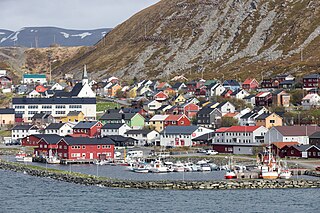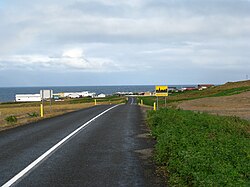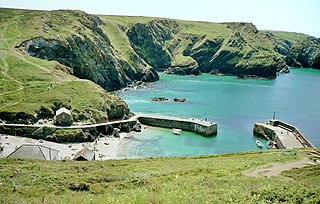
Tsing Yi, sometimes referred to as Tsing Yi Island, is an island in the urban area of Hong Kong, to the northwest of Hong Kong Island and south of Tsuen Wan. With an area of 10.69 km2 (4.13 sq mi), the island has extended drastically by reclamation along almost all its natural shore and the annexation of Nga Ying Chau (牙鷹洲) and Chau Tsai. Three major bays or harbours, Tsing Yi Lagoon, Mun Tsai Tong and Tsing Yi Bay (青衣灣) in the northeast, have been completely reclaimed for new towns.

Rørvik is a port town and administrative centre in the municipality of Nærøysund in Trøndelag county, Norway. It is on the eastern side of the Vikna archipelago on the island of Inner-Vikna. The 1.82-square-kilometre (450-acre) town has a population (2022) of 3,385 and a population density of 1,715 inhabitants per square kilometre (4,440/sq mi).The municipality has a population (2022) of 9,840.

Port Isaac is a small fishing village on the Atlantic coast of north Cornwall, England, in the United Kingdom. The nearest towns are Wadebridge and Camelford, each ten miles (16 km) away. A nearby hamlet, Port Gaverne, is sometimes considered to be part of Port Isaac. The meaning of the village's Cornish name, Porthysek, is "corn port", indicating a trade in corn from the arable inland district.

Fécamp is a commune in the Seine-Maritime department in the Normandy region in north-western France.

Sørvágur is a village on the island of Vágar in the Faroe Islands.

Kjøllefjord is the administrative centre of Lebesby Municipality in Troms og Finnmark county, Norway. The village is located on the northwestern part of the Nordkinn Peninsula, on the shore of a small fjord which empties into the larger Laksefjorden. The 0.45-square-kilometre (110-acre) village has a population (2017) of 945, which gives the village a population density of 2,100 inhabitants per square kilometre (5,400/sq mi) and makes it the largest village in the municipality and one of the largest fishing villages in Finnmark county.

Styrsö is a small island and a locality situated in Göteborg Municipality, Västra Götaland County, Sweden. It had 1,304 inhabitants in 2010.

Lybster is a village on the east coast of Caithness in northern Scotland. It was once a big herring fishing port.

Stöðvarfjörður is a village in east Iceland. It sits on the Northern shore of the fjord of the same name, is part of the municipality of Fjarðabyggð and has less than 200 inhabitants.

Höfn or Höfn í Hornafirði is an Icelandic fishing town in the southeastern part of the country. It lies near Hornafjörður fjord.

Vopnafjörður is a village and municipality in Northeast Iceland, standing on a peninsula in the middle of a mountainous bay by the same name. The main industries of Vopnafjörður are fish processing, agriculture and tourism and other services.

Cesenatico is a port town with about 26,000 inhabitants on the Adriatic coast of Italy. It is located in the province of Forlì-Cesena in the region of Emilia-Romagna, about 30 kilometres (19 mi) south of Ravenna. Cesenatico's port canal was surveyed and drawn by Leonardo da Vinci at the request of Cesare Borgia, as part of his plans to fortify the nearby town of Cesena.

Selá is a river in Vopnafjörður, Iceland, and one of Iceland's most exclusive rivers for salmon angling.

Vágur meaning bay is a town and municipality on the island of Suðuroy, part of the Faroe Islands

The cuisine of Iceland has a long history. Important parts of Icelandic cuisine are lamb, dairy, and fish, the latter due to the fact that Iceland has traditionally been inhabited only near its coastline. Popular foods in Iceland include skyr, hangikjöt, kleinur, laufabrauð, and bollur. Þorramatur is a traditional buffet served at midwinter festivals called Þorrablót; it includes a selection of traditionally cured meat and fish products served with rúgbrauð and brennivín. The flavors of this traditional country food originate in its preservation methods: pickling in fermented whey or brine, drying, and smoking.

Barcombe Mills is a small settlement and an area of countryside including a local nature reserve near the village of Barcombe Cross in East Sussex, England. It is located in the civil parish of Barcombe in the Lewes District. It is an important area for its wildlife, natural environment and water storage. The River Ouse and Andrew's Stream, one of its tributaries and popular for fishing, flow through the area and Barcombe Reservoir is adjacent. The area includes a small hamlet and some farms, including Barcombe House, and a water treatment works.

Portskewett is a village and community (parish) in Monmouthshire, south east Wales. It is located four miles south west of Chepstow and one mile east of Caldicot, in an archaeologically sensitive part of the Caldicot Levels on the Welsh shore of the Severn Estuary. The Second Severn Crossing passes overhead carrying the M4 motorway. The community includes Sudbrook, Crick and Leechpool.

Puerto Ángel is a small coastal town in the Mexican state of Oaxaca located in the municipality of San Pedro Pochutla. It, along with San Agustinillo and Playa Zipolite are known as the "Riviera Oaxaqueña". It is located 9 km south of city of Pochutla approximately 50 kilometers west of Huatulco and 80 kilometers east of Puerto Escondido. Despite tourism development since the 1960s, the town is still mostly a fishing village, located on a small bay surrounded by rocky hills that lead into the Sierra Madre del Sur. It was founded in the mid-19th century as a port for the region's coffee and lumber industries but since then other means of shipping these products has replaced it.

Fishing in Cornwall, England, UK, has traditionally been one of the main elements of the economy of the county. Pilchard fishing and processing was a thriving industry in Cornwall from around 1750 to around 1880, after which it went into an almost terminal decline. During the 20th century the varieties of fish taken became much more diverse and crustaceans such as crab and lobster are now significant. Much of the catch is exported to France due to the higher prices obtainable there. Though fishing has been significantly damaged by overfishing, the Southwest Handline Fishermen's Association has started to revive the fishing industry. As of 2007, stocks were improving. The Cornwall Sea Fisheries Committee is one of 12 committees responsible for managing the corresponding Sea Fisheries District. The Isles of Scilly Sea Fisheries Committee is responsible for the Scilly district.


























